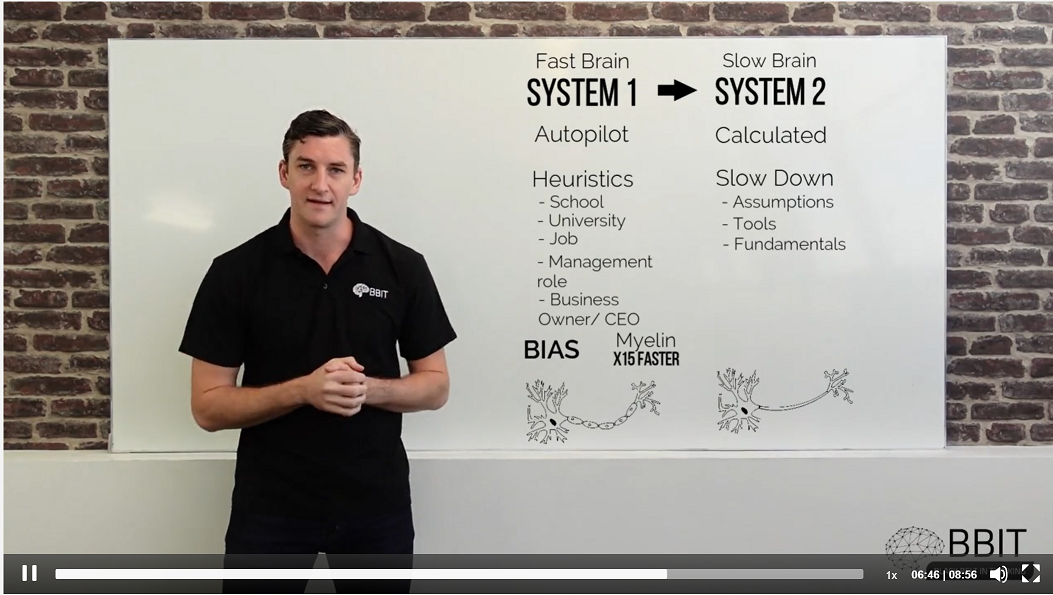In Part 1 of the series, I covered the key elements of the Black Belt in Thinking (BBIT) Boot Camp that make it unique and easily developed into an online course.
In Part 2, I covered the journey we went on testing and measuring the application of the elements.
Finally, I’m sharing a summary of our elements which can be used as a quick reference for others. For each element I give the Need we had which necessitated we include a new element, the element itself (of course) and the Effect we got from the inclusion of the element.
| Course Element | Needs | Effects |
|---|---|---|
| Cohort Based People start the course and progress through at the same rate. | People don’t keep up on a self lead course with no time pressures. Low completion rates and low skill transfer from sporadic learning. It is hard to learn from others when we are at different stages to them. Live interactive sessions are ineffective due to inconsistent progress. | People move through the course at a consistent pace with a consistent workload. Improved learning retention and skill development. Group learning is possible due to progress being mostly aligned. Live interactive sessions are valuable and relevant to the participants progress. |
| Hands on instructors Instructors review work, run group sessions, and are available for one on one calls. | People can miss out on key course value if they don’t ‘get’ a certain element or misunderstand something. Can’t detect and correct errors in learning. Just completing a curriculum doesn’t necessarily cause people to get the best effect. | People are assured to get the key course content, as well as getting extremely high value if they have high value situations they wish to engage instructors on. More reliable learning outcomes with lower risk. |
| Theory Videos Videos which can be accessed at any time with theory, examples, and how to guides. | Live explanations are often not perfect examples, and certain points of content can be missed when presenting live. Inflexible learning when everything must be attended at a certain time. | Learners get a very clear and to the point first introduction to the tool. They can review the theory to refresh themselves whenever needed. |
| Example exercises Exercise with simple and clear situations that are not ‘real’ for participants Example answers to review against. | People are often so worried about being wrong that they won’t try/make a start especially if it is marked by instructors. Learning about something does not translate into being able to do it yourself. Difficult to know if you are on the right track when first learning to do something new. | Low pressure and simple way to start the learning process. Learners practice at applying the tool to an example, and learn their own simple initial mistakes by reviewing it themselves against an example answer. Learners are able to self-review their work, find their own mistakes in a non-threatening way. |
| Live Session Live examples of using the tool on real situations and extra tips. Time for Q&A | The video examples are clear but can be too clean to see what ‘real’ tool use looks like i.e. how they will use it themselves for real. People sometimes feel that they need to use the tool perfectly to be worth it. This means they often don’t use it at all due to a lack of confidence. Some people learn better by watching someone else. | Learners understand how the ‘textbook’ version looks from the theory and their exercises. They also see how practical and quick the tools are to solve everyday situations. Learners have the confidence to go out and try and just get close enough. |
| Live Group Session Smaller group sessions with high involvement, focused on a pivot game for that week’s tool. | Pivots are the key value of a tool, however, are not clear to a new learner as they learn all the elements of new tool. If not drilled, it is easy to miss the value of the tool. Group learning is often missed out on in remote courses | Learners have increased fluency in the tool itself as well as a more developed change in the way they see and think from the tool pivot. Learners have a structured opportunity to work together and learn from each other. |
| Application exercises Taking the learning and applying it to real life problems/scenarios they are in. | Without real application it all looks like nice theoretical tools. People leaving a course without having solved anything are unlikely to start after the course. When first learning something, skills are low and it can be hard to learn and practice alone. | Learners solve their problems as they go on the course, they have enough experience to use the tools outside of exercises before the course ends. Learners can develop their ability to use the tools in real situations while still in the course and with the support of instructors. |
| Reviews/feedback Instructors review the application exercise and provide feedback. | We can only self assess our improvements to a certain level. People don’t know what they don’t know. It can be frustrating when stuck on a new tool, and we don’t want to ingrain incorrect tool use from the outset. | Learners get focused on what they need to improve Learners get the support and feedback they need to quickly develop their skills and become competent in what they have recently learned. |
| Online Community Circle – an online community where people can share examples in their cohorts, as well as engaging with the wider BBIT community. | We are limited by availability bias of where to use the tools. People are concerned they won’t have others to talk to about the tools after finishing the course. | Learners have an expanded view of what the tools can be used to solve by seeing how and where others use the tools. Learners have a way to interact with others on the current course and with past participants. Learners can continue to be supported after the course ends. |
| Fast Run Through The final live sessions where learners use all the tools back to back. | There is a lot of content, which by the end of the course can cause people to feel ‘I don’t know if I can use those again’ and ‘I don’t know how it all fits together’. | Learners leave the course on a high, solving another problem this time but running through all the tools sequentially. Leaners gain confidence in the tools and their ability. |

